




We hardly know Renault and Peugeot other than as direct competitors of each other. Yet long ago there was a close collaboration between the two French manufacturers. This resulted in this special creation: the Renault Project H.
In the second half of the 60s, Renault and Peugeot saw with sorrow how the competition was thriving in the top segment. Not only did Citroën (then not yet associated with Peugeot) still manage to achieve good sales results with the DS; The arrival of successful entries was also threatened from abroad. The creation of the EEC ten years earlier and the free trade that came into effect in 1968, for example, allowed Mercedes-Benz to do excellent business in France. Not only the top segment was occupied by the competition, Renault and Peugeot also noticed that their position was under pressure at a lower level.
Collaboration could be a powerful means of providing a rebuttal. In 1966 this led to an alliance between Renault and Peugeot. The two manufacturers entered into a technical partnership. They would develop and build parts together to keep costs down. Behind the scenes plans were not only set up to jointly build engines, but also work on various study models that would bring the best together. In 1967 various sketches were presented to each other. Ultimately, at least one of them was developed into a physical prototype: the Renault Project H.
Project H
The Project H was Renault’s vision of a top-end luxury car with all the trimmings that was then possible in collaboration with Peugeot. In that regard, the Project H did not disappoint. The striking carriage, designed by Jean-Claude Mornard, stretched for no less than 4.90 meters. The Project H was also quite broad; 1.88 m. A stately whole that had to whiz past comfortably on a variant of the hydropneumatic suspension that Peugeot had developed in response to Citroën. In the interior it looked just as impressive as on the outside. The two extremely spacious front seats joined together in the middle of the car, making it more of a sofa. In terms of design, it is most reminiscent of the interior of the much later released Renault 25. The height of the seat was adjustable in the front and rear. If the seat wasn’t already great, the air conditioning and climate control over different zones (!) Would take care of it.

The interior of the Project H. (Photo: Losange Magazine)
In the very minimalist designed dashboard of the Project H was a speedometer that went up to 200 km / h. Not overly fast, but for that time certainly still a magical limit for passenger cars. Whether the Project H could actually run to the end of that counter is not known, but we would not be surprised. In the nose of the Renault was a 3.5-liter V8. Yes, a Renault with a V8. Not of our own make, however, because this is where partner Peugeot came into play again. It had developed the power source. How much power could be squeezed out remains a question that may never be answered. The V8 was put in a corner with the Project H to start dusting.
Heritage
Although the Project H certainly looked promising and it was clear that Renault together with Peugeot was able to create a luxury top class limousine, Renault eventually decided against it. The Renault 30 is the car that you can see most as a spiritual descendant of this Project H. At Peugeot they eventually went higher with the 604 and that car also has the genes of this Renault in it. Although the V8 was pushed into the corner, Renault and Peugeot did go together on the V6. The PRV engine (with the V from the later hooked up Volvo) became a V6 originally intended as a V8. Most likely the V8 that lay in the nose of this forgotten concept car.